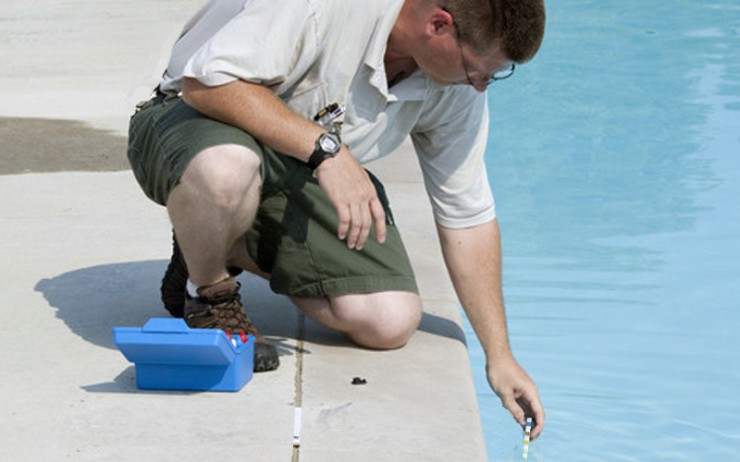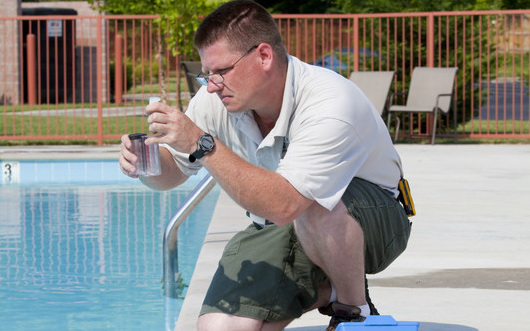Phosphates are hard to detect in a pool, but once they reach a certain level, they can cause algae to grow. If you find your pool is having trouble holding chlorine or it’s turning green, it may be phosphates.
Here is a guide on how to test for phosphates in your pool.
Methods for Testing Phosphates
There are two ways to test for phosphates in swimming pools:
- Professional Pool Store Test
Although pool maintenance is something that a pool owner can do, I would have your water professionally tested once a month. Unless you’re using a high-quality test kit, sometimes home kits can have skewed readings, or the color range doesn’t match the color chart exactly.
And home test kits generally don’t test for ALL types of phosphates.
Even as a pool technician, I have my pool water tested once a month at a supply store.
If you decide to have a professional test, take a sample of pool water to your local pool store, and they will test the phosphate levels.
- Home Phosphate Test Kit
There are two kinds of home phosphate pool test kits you can get:
1. Phosphate Test Strips

Phosphate test strips are the easiest and fastest testing method. Regular test strips don’t usually test for phosphates, so make sure you get test strips specifically for phosphate testing.
Test strips are the least accurate way of testing out of all of the testing methods.
2. Liquid Test Kit

I highly recommend a liquid test kit. I have found them more reliable than strips. Liquid test kits are the choice of most pool professionals. They’re generally more expensive and a bit fiddly to use than test strips. However, they are more accurate. Again, most kits don’t test for phosphates, so make sure you get a kit that does.
Article Contents
How To Test Phosphate Level in Pool Water
How do you check for phosphates in your swimming pool? You need to use a phosphate test kit.
Most test strips test for the basic chemicals: pH, chlorine, and alkalinity. These are the most fluctuating chemicals, so the test strips make sense for this purpose.
Again, you only need to test for phosphates once a month, any time heavy fertilizer has been used, or something similar.
Step 1. Dip the Test Strip in the Water or Fill the Test Tube
For a test strip, dip it into the water and shake off the excess.
For a liquid test, fill the test tube to the fill line, add the proper amount of reagent drops, and shake the test tube for 30 seconds or as the manufacturer directs.
Step 2. Check the Test Results
Compare the strip or the color of the test tube to the color chart provided by the test kit. Phosphate levels should be < 500 PPB.
Step 3. Test Again If Phosphates High
If the level is high (> 500 PPB), test again, just to be sure.
Step 4. Add Phosphate Remover
If the second strip reads high, add phosphate removal treatment.
Step 5. Retest the Next Day
After you’ve applied the phosphate treatment, test the water again the next day,
Step 6. Add More Treatment if Necessary
When using any pool chemical, it’s always better to add too little than too much. If, after re-testing, you find the phosphate levels are still higher than 500 PPB, add more treatment if needed.
Pro Tip: If you’ve had a test kit laying around the garage for a while, ensure it is less than a year old and/or not past the expiry date. Test strips and reagents have an expiration date and will not work properly beyond this date.
What to Do if Phosphates Test High
Treating high phosphates is super easy and affordable. The recommended range is below 200 PPB, but I wouldn’t be alarmed unless it’s over 500. In fact, I took over a routine pool service for a homeowner, and his phosphate levels were literally off the charts. I added a half bottle of phosphate remover, which solved the problem.
If you want to reduce your phosphates, check out our about lowering phosphate levels.
How to Choose a Test Kit for Phosphates
When looking for a phosphate test kit, here’s what you need to look for.
- Simplicity
Liquid test kits are more accurate when used properly; however, they won’t give accurate results if misused. Test strips, for this reason, maybe more suited to some people.
- Accuracy
Without accurate test results, you may add phosphate remover when you don’t need to. Liquid test kits are most reliable when used correctly. Also, look out for brands with solid reputations, such as Taylor.
- Expiry Date
Test kits do go out of date. For that reason, check the expiration date before buying. Or buy your test kit from a reputable store with a fast stock turnover.
Will a Normal Test Kit Test Phosphates in Pool Water?
Standard pool test kits do not test for phosphate levels. Phosphates fall under the “minerals” section with copper and will need an additional test. DPD tests test for oxidizer levels and will not show your phosphate levels.
However, the Taylor D-1106 measures everything and is what all the pros I know use.
How Much Do Phosphate Test Kits Cost?
A home phosphate kit costs from $15-$45. They are handy, especially if you live in an area with high fertilizers or paver stones. Make sure the range goes above 500 PPB. As I said earlier, 200 PPB could be treated, but anything above 500 needs to be treated.
Recommended Test Kits for Phosphate Testing
Taylor K-1106
This Taylor K-1106 test kit is on the upper end of the price scale but totally trustworthy. If you don’t have a major issue with phosphates, you could go with a cheaper version. But, by and large, Taylor is the most reputable.
AquaChek Phosphate Test Kit
AquaChek is a reputable brand and one that a lot of pool owners I know use. It is a test strip that comes with clear directions and a nice color chart. This version comes with two bottles and a total of 40 strips and is a reasonable price.
EasyTest
EasyTest is probably the best option for everyday pool maintenance. It tests for basic chemicals like pH, chlorine, and alkalinity, but it also tests for phosphates. The bottle costs less than $15, and I carry them. These are perfect for routine maintenance for a pool that doesn’t have regular phosphate issues.
These strips give you peace of mind and are reliable. If you are getting a high reading, I suggest doing the test again before unnecessarily adding phosphate remover.
How Often To Test for Phosphates
Generally, you only need to test for phosphates every 1-2 months. However, if you’ve had problems or are constantly getting algae blooms, it’s advisable to test for phosphates more often – every month should suffice.
Additionally, if you’ve recently had some landscaping work done or have fertilized your garden, you may want to test after the work. Fertilizers are sources of phosphates, and it’s common for them to get into pools via water runoff.
Final Advice On Testing for Phosphates
Phosphates are a weird problem that doesn’t directly harm your pool but can have major indirect issues. They don’t stain, they don’t cause cloudiness, and they are not harmful to bathers. However, if you have a sudden algae bloom, but all your systems are well maintained, this is probably the cause.
If you pay for a monthly professional pool service, your pool will remain healthy, and the chemicals will remain in range. However, testing for minerals (phosphates, copper, etc.) is usually not part of the routine maintenance check. Some companies test for these weekly, so check with your pool service.
As stated above, I am a pool technician and took over a pool for a client, and the phosphate levels were through the roof, but the pool was crystal clear. This isn’t a knock on the pool maintenance industry, but these tests are not generally done unless there is a specific reason to do so. If you have a pool service, ask them to test for phosphates at least once per month.
The reason is that high phosphate levels are rare, and testing for them weekly is, quite frankly, a waste of money and time. So, a simple request to your pool maintenance company or a cheap strip tester is the best option. I opt for the Taylor kit, but I use it on multiple pools per week, so the cost is justified.
The main concern with a high phosphate level in your pool is that it is a main food source of algae. However, if your chemicals, especially chlorine, are good, algae will not be able to grow. A lot of information on the internet states that phosphates “don’t matter” in your pool. That is just simply not true.
You will never notice, visually or physically, that your phosphates are high unless your chemicals are unbalanced and algae blooms; that’s true. But, if the phosphates are high, and there is an exceptional circumstance, your pool will turn green, wasting your time and money.
So my advice is this.
Test for phosphates once per month unless you live in a highly fertilized area like a golf course, and treat it for less than $20 if it’s high.

